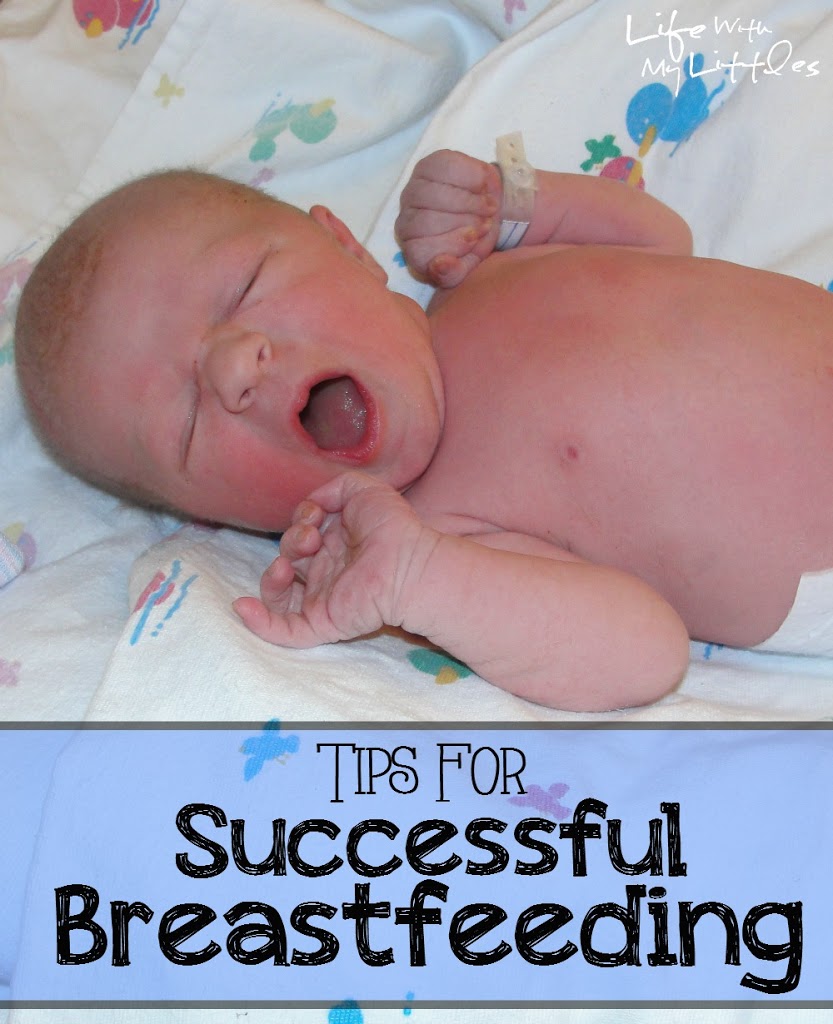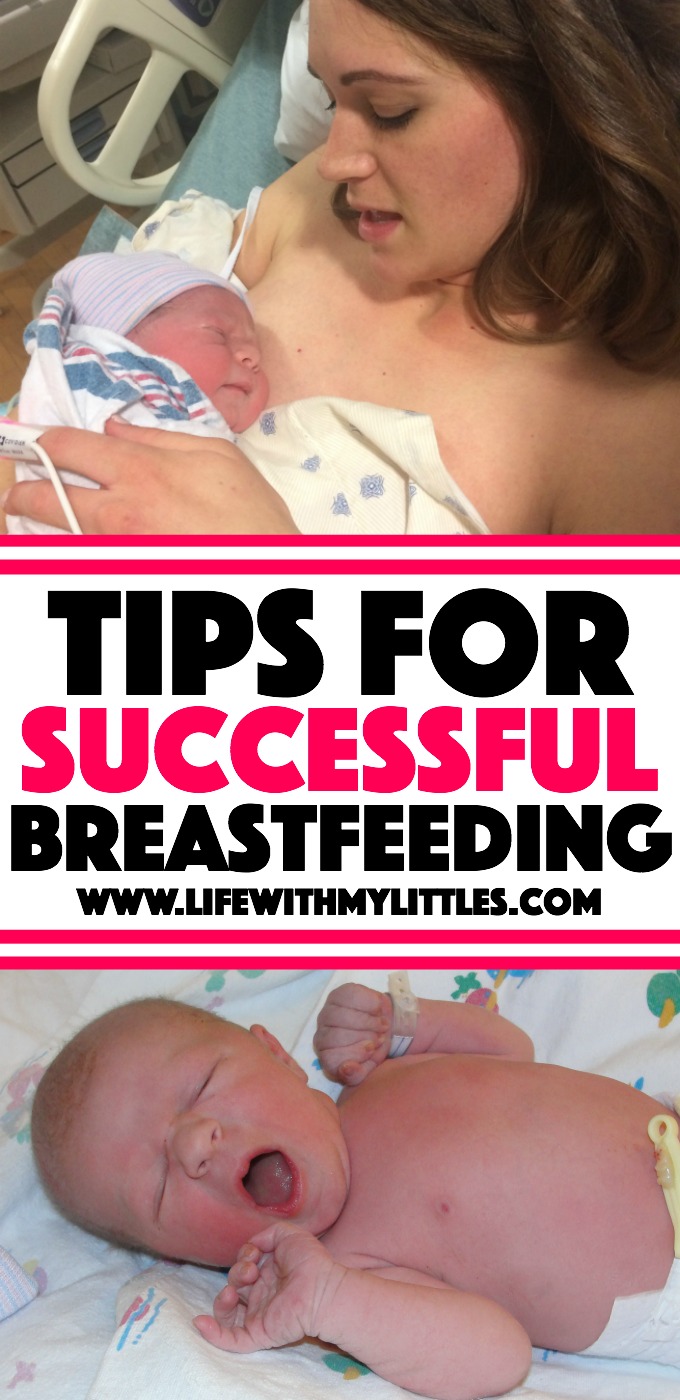Tips for Successful Breastfeeding: How to tips from a mom of two to help make breastfeeding easy, comfortable, and a great experience!
I received free product in exchange for this post.

Before Little J was born, I knew I wanted to breastfeed him. I knew that that was the best way to get him antibodies and keep him healthy and give him the best start I could (thanks college infant development class). But I also had heard breastfeeding horror stories about painful, engorged breasts, bleeding nipples, and babies who just won’t do it. Needless to say I was a little worried. I took a class, read articles online, and asked my nurses everything they could tell me to help breastfeeding be successful. And I was able to breastfeed Little J until he was 8-months-old and my supply got low. With Little A, I knew from the start I wanted to breastfeed her, too. I read up on all my tips I had gotten with Little J, and now I am here to share them with you!
Breastfeeding shouldn’t be a battle, it shouldn’t be uncomfortable, and it should not be something you dread. It should be a bonding experience and something that you look back on fondly when your child is older. If it’s not working out, it is okay to stop breastfeeding. The day I stopped breastfeeding Little J, I cried because it was something I was going to miss doing with him. Since he moves constantly, it was nice to have some quiet time where I could just hold him close.
But anyway, that doesn’t help you. You are here for tips. So here are my tips for successful breastfeeding!
When First Beginning to Breastfeed
Breastfeeding as soon as possible after baby is born really helps baby start breastfeeding strong.
Self-expressing helps baby go to the breast. Place your fingers directly above and below the nipple and gently compress in, then together.
If baby won’t latch himself, put his nose in front of your nipple, tip his head back, place his bottom lip on, and bring the top lip over. When he opens his mouth wide, stick him on!
Baby’s chin should be smashed and his nose touching. I know it will look uncomfortable, but this position will save your nipples from soreness.
There should be more areola showing above baby’s mouth than below. If you don’t know, the areola is the brown part around your nipple.
Avoid using pacifiers or bottles for the first 3-4 weeks. It can lead to nipple confusion. If you are tempted to use a pacifier because baby is crying, just try swaddling, shh-ing, and swaying.
Listen for swallowing. You want to make sure your baby is actually getting breastmilk, otherwise, you will need to reposition them.
Try different positions and find what works best for you and your baby. (The four positions are the football hold, the cradle hold, the cross-cradle hold, and lying down.)
If Your Nipples Are Sore
Try nursing more frequently for shorter periods. This can help because you won’t be feeding for as long, and while you may think that it would be worse because you have to nurse more often, I promise you, it will help.
Changing baby’s position can help vary the pressure points created by baby’s mouth. You can try any of the four standard breastfeeding holds: cradle, cross-cradle, football, and lying down. I personally was a fan of the cross-cradle fan with Little J, but everyone prefers different things.
LANOLIN. If your nipples are dry, cracked, or bleeding, try using some lanolin. Just apply a pea-sized amount after nursing (or showering, too) and it can really help to heal those cracked nipples. And the best part is you don’t have to worry about wiping it off before you feed baby next because it is natural!
Try some hydrogel pads. They are like gel packs that you put in the fridge and then put on your breasts between feeding. They are small and feel amazing, even though it may seem kind of weird. Do not use heat! That is pretty much the opposite of what you want. The hospital gave me a sample of some hydrogel pads and they were lifesavers those first few days and weeks. You can buy them at Target, Walmart, or other baby stores.
After Breastfeeding Has Been Established
When your baby finishes feeding on one breast, offer the second, He probably won’t eat as long on the second breast, but then the next time you feed him, start with the breast you ended on last time. And it is really helpful to wear a hair tie on your wrist on the side he ends on so that you know which side to start on next time!
Stroke baby’s hands, legs, or feet if he gets sleepy during feeding. If that doesn’t help, try taking off his clothes. This mostly happens when baby is little, and not so much as they get older. It’s especially common when you feed baby at night (for obvious reasons).
Burping with breastfeeding isn’t necessary, but it helps between breasts and at the end. Air in the tummy may make baby irritable and not cooperative, so if you are having difficulties, try burping your little one!
If baby shows disinterest try to stimulate baby’s rooting reflex by touching baby’s cheek or lips with your nipple. This may help him latch on and then realize that it’s time to eat!
If you have a painful lump on your breast, try massaging it while baby is nursing. Throughout the time I breastfed Little J, I would occasionally get clogged ducts. It really helped to massage them in a circular motion while he was eating. It may not go away immediately, but it sure helps!
Avoid using soap on your nipples because it can lead to soreness and cracking. You obviously can’t help getting shampoo on your body when you rinse your hair, but when you are using body wash, skip your nipples and you should be fine.
If engorged between feedings, you can pump or even just self-express a little bit. Sometimes baby won’t eat as much because he isn’t feeling well or maybe he just isn’t as hungry one day (as long as he has normal diapers, he should be fine). If this happens, you might get engorged. Using a breast pump after or between feedings can help get rid of a little of that engorgement. And if it’s just a little painful, you can just try to self-express a little bit by placing your fingers above and below your nipple and compressing. Sometimes just a little bit is all it takes to feel better.
One of the most important tips I can give you for successful breastfeeding is that you need to be comfortable both when you are breastfeeding and when you aren’t. The best way to do this is to have a supportive bra, like one of these. You need a comfortable bra that is supportive, but not restrictive. A bra that is too tight can lead to engorgement, plugged milk ducts, or a breast infection. You also want one that will be easy to use while you are actually breastfeeding.
And if you need some suggestions on more breastfeeding essentials to keep with you to make breastfeeding better, read more here!

spiritedlife says
These are some great tips. I didn't have problems breastfeeding any of my children, but others seem to have problems. I think with a little more information like this page, succinct and useful, more women would be willing to try.
Chelsea says
Agreed! There are lots of things you can do to make breastfeeding work and make it better when you are struggling. Hopefully people can see this and keep trying!!
Chelsea says
Thanks! It's been a little harder this time around, but patience is key!!
Kersten Lindhardt says
These are wonderful tips! Being informed is the best thing that helped me successfully breastfeed my son and now my daughter! Lanolin is definitely a life savor, and with my baby girl a friend recommended using coconut oil for sore nipples as well. Between Lanolin and coconut oil, I really had no problems with any soreness/dryness/cracking this time around!
And I totally agree about how critical a good bra is. I am a huge fan of the Bravado brand and can't wait to hear your thoughts!
EMily says
great tips!! SO many new moms need to have all the facts in hand when breastfeeding… it doesn't just always happen and when it gets hard many quit. I love how you have put it all here. Pinning!
Lexie says
Great tips! I also liked using coconut oil instead of lanolin. I would also recommend watching you tube videos on breast feeding. It seems weird but it was so helpful for me especially when I was struggling to get my baby to have a good latch. Watching someone actually do it was so much different then someone just describing how to do it, because sometimes it's hard to visualize.
Jessica says
Love this, Chelsea! This wouldn't be an easy post to write because of all the detail you'd have to go into, and you did just that! Very informative, thanks for sharing!
Chelsea says
I haven't heard of using coconut oil, but I have some in the pantry so when my lanolin runs out I know what I will be using! Thanks for the tip!!
Chelsea says
No, that's totally smart! And sometimes pictures don't help either, so seeing someone else do it would be helpful. Great tip, Lexie!
Chelsea says
Thanks! I think you are probably a breastfeeding pro after breastfeeding two for so long, so that means a lot!
Julie S. says
These are great tips! I'll be needing them in about 7 weeks 🙂
Chelsea says
How exciting!! I hope it goes amazing for you!
Lena says
I didn't think breastfeeding was going to hurt the second time around because I knew what a good latch was and how it was supposed to look and feel… Even though we were doing it all right it still hurt terribly for the first few days until my nipples got used to it again. So sore!!!!
Chelsea says
Me too! I was surprised by that as well. But it doesn't hurt now so we are all good!
Eve says
I think it's a little misleading to say breastfeeding shouldn't be uncomfortable…it will hurt like hell for the first few days and weeks! I didn't stop wincing in pain every time lo latched until she was about five weeks old, and my nipples were cracked and bleeding even though she was latching perfectly. That IS normal, and we are now still happily nursing pain free at eleven months, but I think you will discourage women from trying to power through the beginning if you make it sound like it should be easy and painless.